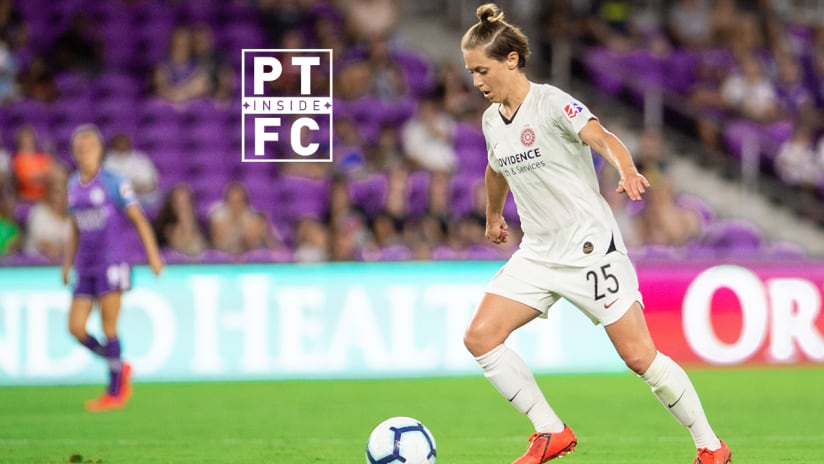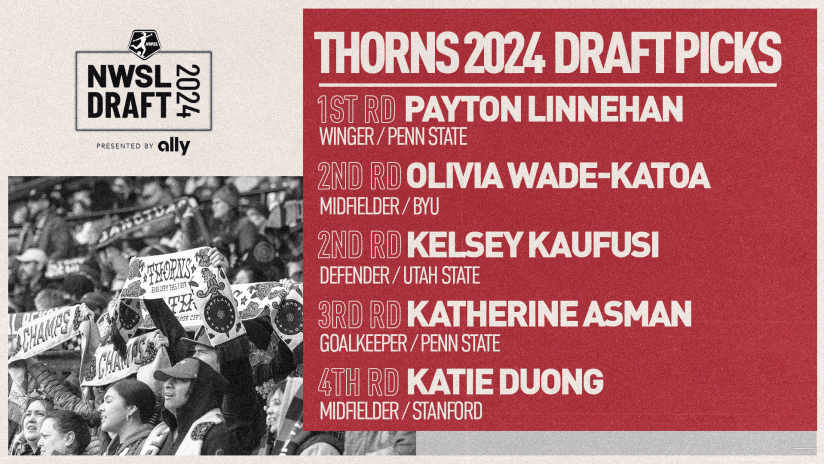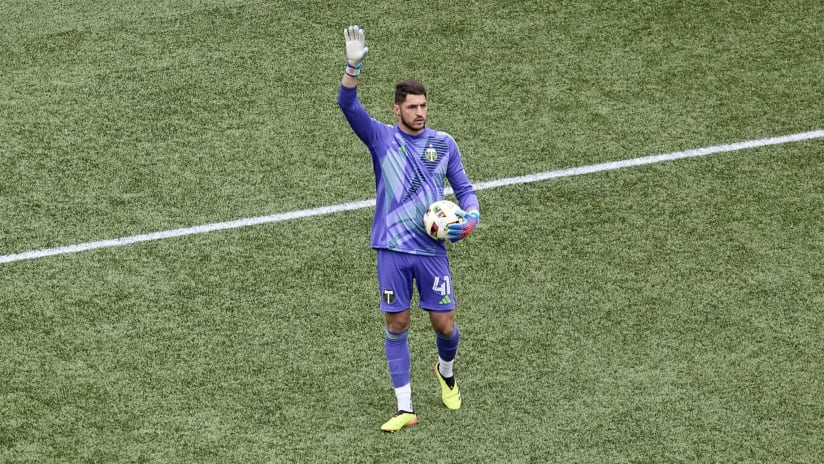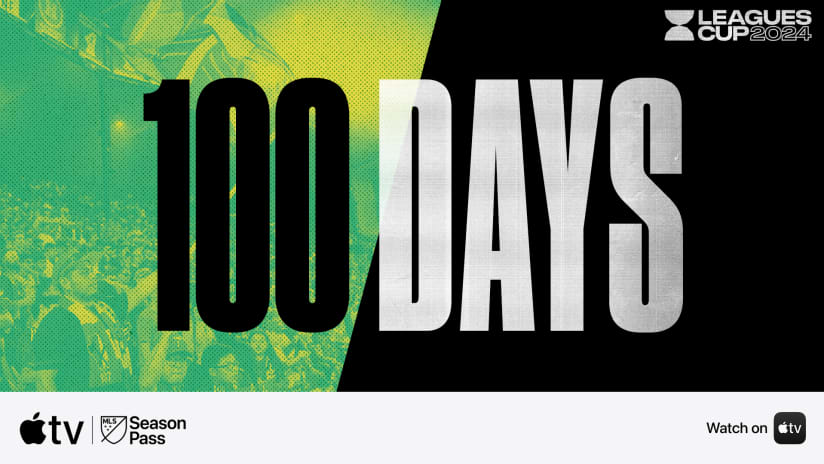The early returns on Portland Thorns FC's new world have been positive. Amid the fears of what the two-time National Women’s Soccer League champions would be after their 2019 FIFA World Cup departures began, the team has scored five goals in two games, with Lindsey Horan’s hip injury before the team’s visit to Sky Blue FC two weeks ago giving Portland an early glimpse of their future. Saturday in Orlando, another stage of that future arrived, with the Thorns having lost goalkeeper Adrianna Franch, midfielders Tobin Heath and Christine Sinclair, and defender Emily Sonnett. The 3-1 victory over the Orlando Pride was, at worst, a positive omen.
There is a problem with looking at isolated scorelines, though. By now, soccer fans know this too well, especially those from Portland who endured Friday’s Timbers game in Vancouver. Over 90 minutes’ time, you can generate all the chances you want yet see your team left empty handed after great goalkeeping or uncharacteristic misses. Variance, people who see it in numbers might call it, because it also works the other way. You can have games where you only generate two good chances yet walk away from a match scoring twice, or have the other team pull the same trick against you. In time, those types of numbers will even out, returning to their natural mean, but through single-game samples, it’s hard to tell the future.
That’s why the Thorns’ early returns have to be seen as just that: early returns. Eight points through four road games is a great bottom line, especially considering the team is still three weeks from their first minute at home. But if we’re trying to make an honest assessment of where Portland’s at, right now – or, where they might be over these coming, short-handed nine weeks – we need some evidence that’s more robust than goals for and goals allowed.
Coaches and technical staffs do this evidence all the time, looking beyond the scoreboard to a number of different indicators. You’ll occasionally hear coaches weaponize these stats in interviews, saying things like, “Sure, we were shut out, but if our chances created and final-third entries stay strong, we’re going to be OK.” Possession, big chances, touches in opposing penalty areas and passes in the opposition half also get tracked, and since most happen more often than goals, they tend to provide a broader, more consistent picture of whether your team’s doing the right things to impact the scoreboard.
Let’s track some of those numbers over the first four games of the season, four games that, from a certain (disputable) point of view, form a progression. From a first game against a Pride team installing a new approach, to a second match against a Chicago Red Stars group that is among the league’s most talented, to a third game in New Jersey without last year’s Most Valuable Player, to an Orlando return played without five regular starters, Portland has seen new challenges each week, with the most recent leaving them close to their coming, World-Cup world. Four more players will depart, soon, but as Portland’s reality has evolved, we’ve started to see the challenges that will come.
<strong>Match</strong> |
<strong>Opponent</strong> |
<strong>Big Chances Created</strong> |
<strong>Shots, Total (inc. Blocks)</strong> |
<strong>Total Shots Inbox (inc. Blocks)</strong> |
<strong>Total Shots OutBox (inc. Blocks)</strong> |
<strong>Chances Created (inc. assists)</strong> |
<strong>Chances Created from Open Play</strong> |
<p align="right">1</p> |
<p align="right">Orlando Pride</p> |
<p align="right">4</p> |
<p align="right">23</p> |
<p align="right">13</p> |
<p align="right">10</p> |
<p align="right">20</p> |
<p align="right">16</p> |
<p align="right">2</p> |
<p align="right">Chicago Red Stars</p> |
<p align="right">4</p> |
<p align="right">10</p> |
<p align="right">7</p> |
<p align="right">3</p> |
<p align="right">9</p> |
<p align="right">9</p> |
<p align="right">3</p> |
<p align="right">Sky Blue</p> |
<p align="right">1</p> |
<p align="right">14</p> |
<p align="right">9</p> |
<p align="right">5</p> |
<p align="right">7</p> |
<p align="right">3</p> |
<p align="right">4</p> |
<p align="right">Orlando Pride</p> |
<p align="right">1</p> |
<p align="right">11</p> |
<p align="right">6</p> |
<p align="right">5</p> |
<p align="right">5</p> |
<p align="right">5</p> |
A big reminder here before things get too serious: The Thorns have only played four games; they’ve been exclusively on the road; and with the changes that have happened since game two, there may be nothing here that constitutes a reasonable sample. This is truly the tea-leaves metaphor playing out, here. We’re looking at the bottom of a cup, trying to bring order to chaos. In reality, it’s probably just chaos.
What you notice in this set of chaos, though, is that the Thorns either got off to a hot start or, with players slowly departing, they are coming back down to earth, even if a lot of that may have been how much Orlando struggled in week one. That’s why we can’t take these numbers too seriously. We can notice patterns, we can start asking questions, but ultimately, we’ll need more data to draw conclusions.
If you divide the games into two groups, though, the differences become stark:
<strong>Match</strong> |
<strong>Opponent</strong> |
<strong>Big Chance Created</strong> |
<strong>Shots, Total (inc. Blocks)</strong> |
<strong>Total Shots Inbox (inc. Blocks)</strong> |
<strong>Total Shots OutBox (inc. Blocks)</strong> |
<strong>Chances Created (inc. assists)</strong> |
<strong>Chances Created from Open Play</strong> |
<p>1-2</p> |
<p align="right">Pride/CRS</p> |
<p align="right">4</p> |
<p align="right">16.5</p> |
<p align="right">10</p> |
<p align="right">6.5</p> |
<p align="right">14.5</p> |
<p align="right">12.5</p> |
<p>3-4</p> |
<p align="right">SBFC/Pride</p> |
<p align="right">1</p> |
<p align="right">12.5</p> |
<p align="right">7.5</p> |
<p align="right">5</p> |
<p align="right">6</p> |
<p align="right">4</p> |
In every category, the Thorns’ numbers are down, with differences in Big Chances Created, Chances Created, and Chances Created from Open Play striking. In each of those areas, they have been half as productive over the last two games as they were in the first two.
Part of the explanation, here, may be performance, not quality. Even identical players give different performances from game to game, making it difficult to tell what their true levels are. Difficult, unless you get bigger samples. Over four games, not only are the small samples a problem. The natural ups and downs, good days and bad of players’ performances can be a debilitating obstacle.
That said, let’s take another step back in the process. We’ve already gone from looking at goals (in the discussion at the top) to looking at chances. Now let’s look at what leads to those chances: passes, and where you have the ball.
<strong>Match</strong> |
<strong>Opponent</strong> |
<strong>Passes, Successful Opp Half</strong> |
<strong>Passes, Into Final Third</strong> |
<strong>Passes played into the box (inc. crosses)</strong> |
<strong>Touches in the Opp Box</strong> |
<strong>Possession Won Final 1/3</strong> |
<p align="right">1</p> |
<p align="right">Orlando Pride</p> |
<p align="right">143</p> |
<p align="right">56</p> |
<p align="right">30</p> |
<p align="right">26</p> |
<p align="right">11</p> |
<p align="right">2</p> |
<p align="right">Chicago Red Stars</p> |
<p align="right">106</p> |
<p align="right">60</p> |
<p align="right">26</p> |
<p align="right">24</p> |
<p align="right">7</p> |
<p align="right">3</p> |
<p align="right">Sky Blue</p> |
<p align="right">188</p> |
<p align="right">65</p> |
<p align="right">41</p> |
<p align="right">25</p> |
<p align="right">11</p> |
<p align="right">4</p> |
<p align="right">Orlando Pride</p> |
<p align="right">101</p> |
<p align="right">65</p> |
<p align="right">39</p> |
<p align="right">27</p> |
<p align="right">4</p> |
What’s most interesting here: the patterns we found, above, get broken. We don’t see the first-two-weeks, next-two-weeks divide that we see in the chances created – a divide that doesn’t exist in the goal scoring, either. Remember: Portland scored six goals over the first two weeks, five in the last two. The difference, there, isn’t worth worrying about.
If the data across these two areas of play were in agreement, there may be something to worry about. Instead, that data is conflicted. Yeah, the team isn’t generating the same number of chances, but in terms of where they’re moving the ball, getting their touches, and how often they’re winning play in high areas, there isn’t much difference. The divide doesn’t look as stark.
<strong>Matchday</strong> |
<strong>Opponent</strong> |
<strong>Passes, Successful Opp Half</strong> |
<strong>Passes, Into Final Third</strong> |
<strong>Passes played into the box (inc. crosses)</strong> |
<strong>Touches in the Opp Box</strong> |
<strong>Possession Won Final 1/3</strong> |
<p>1-2</p> |
<p align="right">Pride/CRS</p> |
<p align="right">124.5</p> |
<p align="right">58</p> |
<p align="right">28</p> |
<p align="right">25</p> |
<p align="right">9</p> |
<p>3-4</p> |
<p align="right">SBFC/Pride</p> |
<p align="right">144.5</p> |
<p align="right">65</p> |
<p align="right">40</p> |
<p align="right">26</p> |
<p align="right">7.5</p> |
It’d be easy here to note that Heath, Horan and Sinclair were missing for all or parts of the last two games, and they’re three of the team’s key presences in the penalty box. That, of course, is true, and it could explain why the biggest hit the Thorns have seen to their indicators have been in the chance creation numbers. But the team has also gotten Andressinha and Hayley Raso back during that time, and they’ve been able to give more minutes to Dagny Brynjarsdóttir. As of last weekend in Orlando, they’re going to be playing against teams that are suffering their own losses. It’s still unclear if, or to what extent, the Thorns will suffer more than their competition during the World Cup.
There’s certainly been a talent loss over the last two weeks, but how that loss is supposed to look in the numbers, who knows? If you want to look at passing and goals scored, the drop doesn’t look that meaningful – a conclusion that wouldn’t exactly make sense, intuitively. If you look at chance creation, though, the drop looks huge, something that doesn’t fit nicely within the other numbers.
The bottom line, here, is that we need more data, even if the numbers we have through four games can’t be ignored. There are questions to ask, here, that can’t be answered right now, but they have to be kept in mind. If the passing numbers dip in the coming games against Washington and Sky Blue, today’s creation numbers will look more telling. Conversely, if those creation numbers improve, you can look at goals scored and the passing indicators and say, “this is what we should have expected all along.”
Coaches look at these numbers and, usually, have to act. At a minimum, they have to decide whether to persist with what they’re doing or change course. From our distance, though, we have the luxury of inaction. We can sit back, wait, and see if and how the underlying indicators end up foreshadowing the Thorns’ course.
Today’s numbers may prove telling. Or, they may prove misleading. Right now, though, they’re just chaos.














